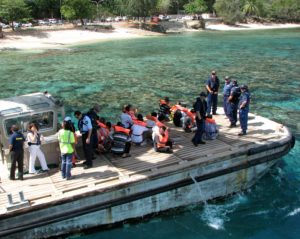Indian Ocean Migration Crisis Takes New Turn
 Indonesian National Police arrested Abraham Louhenapessy, an infamous human smuggler on Friday, September 23. Louhenapessy is known for trafficking hundreds of migrants since 1999, primarily into Australia.
Indonesian National Police arrested Abraham Louhenapessy, an infamous human smuggler on Friday, September 23. Louhenapessy is known for trafficking hundreds of migrants since 1999, primarily into Australia.
Louhenapessy is one of many smugglers who have facilitated a migration crisis throughout the Indian Ocean. Smugglers illicitly sail their customers, often refugees, to more developed nations. Following Louhenapessy’s arrest, the Australian Minister of Justice stated, “...there are more criminal people smugglers out there and we will continue to work with our regional partners to bring them to justice.”
Smugglers operate a lucrative business in an ever-growing market. The UN Refugee Agency reported that approximately 120,000 migrants traversed the Indian Ocean from 2012 to 2014. The report noted that smugglers charge between $1600 to $2400 per person, which amounts to revenues upwards of $250 million.
Regional governments have intensified their efforts to stop the smugglers. Australia, Malaysia, and Indonesia have partnered their naval and coastal defenses to crack down on trafficking vessels. Indonesia also increased prison sentence lengths for smugglers in 2011, following a precedent set by Malaysian legislation.
Despite these efforts, migrants continue to flow in from South and Southeast Asia. Of the roughly 54,000 migrants the UN Refugee Agency reported in 2014, about 21,000 were Rohingya and Bangladeshi. The Rohingya are a stateless Muslim minority of Myanmar, who have endured decades of isolation and violence. Bangladeshis tend to be migrant workers, almost all adult men. Hundreds more refugees come from Sri Lanka, which emerged from a 25 year civil war in 2009.
The regional migration crisis mirrors the current Syrian refugee situation. The exacerbation of various regional crises has fostered a plethora of displaced persons, many of whom look to settle in developed countries like Australia and New Zealand. Most migrants, however, arrive in Malaysia, Indonesia, or Thailand. Borgen Magazine commented on the vulnerability of refugees in these nations, “as all three countries are not party to the 1951 Refugee Convention which governs the international laws pertaining to the rights of refugees.”
Although many asylum seekers seek safety in Australia, the country has faced severe criticism for its refugee policy. Australia implemented the Pacific Solution in 2001, mandating preliminary screening of all asylum seekers at various regional locations, such as Nauru and Papua New Guinea. Human rights groups exposed countless violations at these detention centers. On August 10, The Guardian released the Naura Files which reported 2,116 incidents of “assaults, sexual abuse, self-harm attempts, and child abuse,” at the relocation facility at Nauru. Although Australia has integrated many thousands of refugees, there is still a lot of work to be done. Regional efforts to combat trafficking are commendable, but governments in this area must follow up by assisting in crisis resolution in areas ranging from Sri Lanka to Thailand. With tens of thousands of lives on the line, the migration crisis proves to be a threat toward greater regional stability.
